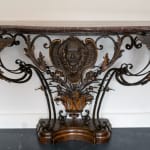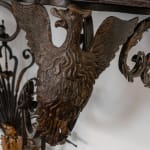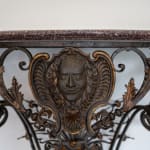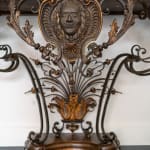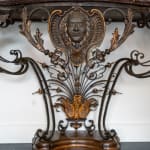Unknown
Further images
A rare and very elegant Louis XV wrought iron, parcel gilt and Egyptian porphyry console table, the moulded shaped porphyry top above a conformingly shaped plain metal frieze above a central and characterful partly gilded male mask issuing from shell motifs flanked by open-work acanthus-wrapped scrolls that are linked to four supporting open-work serpentine legs, headed by naturalistic eagles with spread wings, the male mask head above a gilt acanthus leaf spray that issues bullrush-like sprigs and is placed upon an open-work scrolled plinth with scrolled feet on four balls flanked by the supporting legs with scrolled feet upon a later shaped wooden base
Provence, southern France, most probably Comtat Venaissin, date circa 1740
Height: 90 cm, width 128 cm, depth 54 cm.
Provenance: Until recently a private collection, Geneva.
This highly exuberant console table, known as a console d’apparat, is a rare example of a type of ironwork that was associated with Provence, in southern France and particularly works made in Comtat Venaissin, of which similar examples are illustrated in Alain Renner’s book, “Mobilier de Métal de l’Ancien Régime à la Restauration”, 2009. Inspired by similar pieces made by ébénistes from gilded carved wood, wrought iron consoles d’apparat emerged as ambitious creations made by artisans belonging to the guild of the serruriers-ferroniers who were more commonly used to making works that complemented architectural schemes.
The serruriers-ferroniers drew from the language of architecture. At the same time, they were inspired by designs by the ornamentistes such as Gabriel Huquier (1695–1772), whose “Nouveau Livre de Serrurerie” included similar designs for consoles, as we see here. The serruriers-ferroniers managed to interpret the Baroque, Rococo and later Neo-classical styles and their various motifs by forging the iron into a new expression, resulting in what was described as a “stylisation du style”, as noted in the article “A la Recherche des Meubles de Fer du XVIIIe Siècle Français”, in “Connaissance des Arts”, 1957. The creation of such pieces made from a hard and robust, yet characterful metal was an ancient process in which the iron was heated at extreme temperature. The white-hot metal was then beaten and shaped while the sheet metal was pushed onto sculptured dies. It was then chiselled and finally gilded. The two metals were then joined together by means of screws, rivets and wedges.
When polished, painted, gilt, silvered or applied with repoussé tole, wrought iron takes on a new vitality, full of warmth and richness that could rival works made of carved wood adorned with gilt bronze mounts. Furthermore, wrought iron furnishings provided a durability that wood was unable to offer. This material, when used in furniture, therefore became a sophisticated and rare component of luxurious French interiors from the early Louis XV period onwards. In addition, the physical strength of the wrought iron led to a preference for consoles fixed to the wall, playing with the contrast between the weight of the stone top and the lightness of the open-work design, a feature that carved giltwood was rarely able to achieve.
Only two centres in eighteenth century France appear to have specialised in the creation of such works. One was in Paris and the other in southern France. Those pieces made in Paris were made under the direction of the locksmith and metal worker Pierre Deumier, of which little is known about except that he was active in the 1760s, was received as a maître serrurier and was appointed serrurier du roi et de la ville (locksmith to the king and city). He was responsible for providing metalwork for the royal buildings and various European courts, of which his best-known items of furniture were a pair of Neo-classical silvered and gilt bronze consoles featuring a central female mask, circa 1765-70, which were supplied to the royal castle at Warsaw (now in the Musée de Nissim de Camondo, Paris), as well as a similar example from the same date, after a design by Victor Louis and Jean-Louis Prieur, that is now in the Getty Museum Collection.
The second centre where elegant metalwork furniture was made was in southern France, namely in Provence and the region around Avignon and Marseille, where the grand townhouses were filled with examples that reflected the technical skills and artistic imagination of the local serruriers during the eighteenth century. This is seen in staircases, balconies, and particularly in the many churches, from communion tables, altar rails and canopies, or in simple ornamental motifs.
When it came to the creation of consoles, those made in Paris tended to be more highly polished and sober in design while those made in southern France tended to be more exuberant in style to reflect the tastes of nearby Italy. While we know from old inventories that such consoles were made for a number of private mansions in Aix, Marseille and Avignon, only a very few wrought iron consoles d’apparat, such as the present example, have survived. Even fewer still remain in their original position, counting among them an example at Château d’Avignon in the Camargue. Our piece was almost certainly made in Provence and more specifically at Comtat Venaissin, since the combination of the linear and graphic quality of design compares with the architectural decoration from this region. Other distinctive characteristics include the stylised shell and mask head motifs and the pronounced S-shaped legs.






